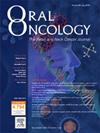Turning tumor microenvironmental foes to friends: A new opportunity for thyroid cancer therapy and redifferentiation
IF 3.9
2区 医学
Q1 DENTISTRY, ORAL SURGERY & MEDICINE
引用次数: 0
Abstract
Cancer cells engage in dynamic crosstalk with their microenvironment (TME), critically influencing tumor progression, metastasis, immune evasion, and therapeutic resistance. Thyroid cancer (TC) exhibits characteristic tumor heterogeneity, together with secreted factors (cytokines, chemokines, extracellular vesicles) and the extracellular matrix, these elements constitute the TME. In addition, TC-TME interactions drive key pathological processes including differentiation status across histological subtypes—from differentiated (DTC) to aggressive variants(poorly differentiated thyroid cancer (PDTC) and anaplastic thyroid cancer (ATC)). A hallmark of malignancy, metabolic reprogramming not only fuels uncontrolled proliferation but also actively remodels the TME through mechanisms including immune modulation, angiogenesis regulation, and stromal reprogramming. At the same time, immunotherapy represents a promising therapeutic frontier for treatment-refractory cases such as radioiodine-resistant DTC (RR-DTC), PDTC, and ATC. Emerging evidence reveals distinct mutational signatures that correlate with TME remodeling, suggesting potential diagnostic and prognostic biomarkers. While current redifferentiation approaches primarily target cancer cells with limited success, novel strategies focusing on TME modulation—particularly targeting tumor-associated macrophages (TAMs), cancer-associated fibroblasts (CAFs), and tumor-associated mast cells (TAMCs)—show therapeutic potential. Deciphering these intricate metabolic adaptations and their bidirectional interactions with the TME represents a pivotal opportunity for developing precision therapies and enhancing treatment efficacy in the clinical oncology of TC. This review synthesizes current knowledge on TME-directed therapies in TC and highlights the urgent need to elucidate metabolic reprogramming and other factors within the TME to develop innovative treatment paradigms targeting both cancer cells and TC-associated immune cells.
将肿瘤微环境敌人转化为朋友:甲状腺癌治疗和再分化的新机遇
癌细胞与其微环境(TME)进行动态串扰,严重影响肿瘤进展、转移、免疫逃避和治疗耐药性。甲状腺癌(TC)表现出典型的肿瘤异质性,与分泌因子(细胞因子、趋化因子、细胞外囊泡)和细胞外基质一起构成TME。此外,TC-TME相互作用驱动关键的病理过程,包括组织学亚型的分化状态——从分化(DTC)到侵袭性变异(低分化甲状腺癌(PDTC)和间变性甲状腺癌(ATC))。作为恶性肿瘤的标志,代谢重编程不仅促进不受控制的增殖,而且通过免疫调节、血管生成调节和基质重编程等机制积极重塑TME。与此同时,免疫疗法代表了治疗难治性病例的一个有希望的治疗前沿,如放射性碘耐药DTC (RR-DTC)、PDTC和ATC。新出现的证据揭示了与TME重塑相关的独特突变特征,提出了潜在的诊断和预后生物标志物。虽然目前的再分化方法主要针对癌细胞,但成功率有限,但专注于TME调节的新策略-特别是针对肿瘤相关巨噬细胞(tam),癌症相关成纤维细胞(CAFs)和肿瘤相关肥大细胞(TAMCs) -显示出治疗潜力。破译这些复杂的代谢适应及其与TME的双向相互作用为开发精准治疗和提高TC临床肿瘤学治疗效果提供了关键机会。这篇综述综合了目前关于TME定向治疗TC的知识,强调了迫切需要阐明TME中的代谢重编程和其他因素,以开发针对癌细胞和TC相关免疫细胞的创新治疗范式。
本文章由计算机程序翻译,如有差异,请以英文原文为准。
求助全文
约1分钟内获得全文
求助全文
来源期刊

Oral oncology
医学-牙科与口腔外科
CiteScore
8.70
自引率
10.40%
发文量
505
审稿时长
20 days
期刊介绍:
Oral Oncology is an international interdisciplinary journal which publishes high quality original research, clinical trials and review articles, editorials, and commentaries relating to the etiopathogenesis, epidemiology, prevention, clinical features, diagnosis, treatment and management of patients with neoplasms in the head and neck.
Oral Oncology is of interest to head and neck surgeons, radiation and medical oncologists, maxillo-facial surgeons, oto-rhino-laryngologists, plastic surgeons, pathologists, scientists, oral medical specialists, special care dentists, dental care professionals, general dental practitioners, public health physicians, palliative care physicians, nurses, radiologists, radiographers, dieticians, occupational therapists, speech and language therapists, nutritionists, clinical and health psychologists and counselors, professionals in end of life care, as well as others interested in these fields.
 求助内容:
求助内容: 应助结果提醒方式:
应助结果提醒方式:


